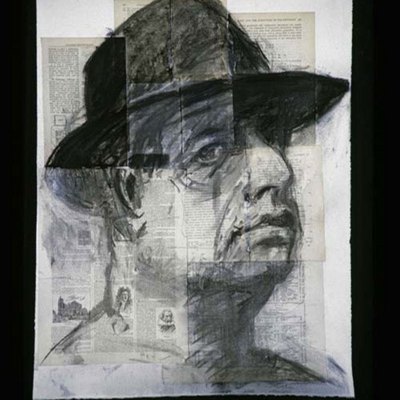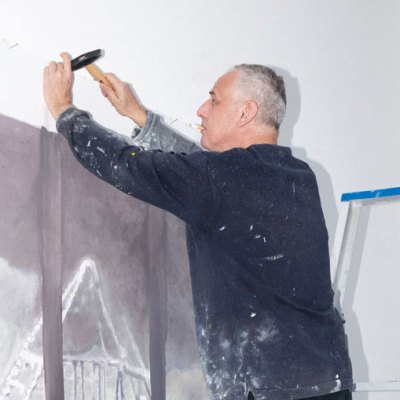It was announced on Wednesday 25 October that the artist Robert Irwin, who shaped environments through his use of light and space, has died at the age of 95. In 2015, this quintessentially Californian artist spoke to Jonathan Griffin in his San Diego studio about the importance of making beautiful pieces and why art should have nothing to do with politics.
In 2007, Robert Irwin (b. 1928) had a retrospective at the Museum of Contemporary Art San Diego. Held in the city in which Irwin has lived since the early 1980s and curated by the museum’s director, his old friend Hugh M. Davies, the exhibition was something of a homecoming tribute for the artist. He did not know it at the time, but a chance meeting during the installation of the exhibition would open the door to an unexpected new chapter in his career, one that this year has come to fruition with exhibitions at Pace, New York, in the spring, and at White Cube, London (until 15 November).
Irwin, now a spry 86 years old, has shaped the history of art in Southern California more significantly, over a longer period, than any other living artist. The influence of his thinking is pervasive – through his years as a teacher to artists including Chris Burden, Vija Celmins, Joe Goode and Ed Ruscha – but his presence in the world’s museums is limited, because for years he made nothing that one could buy or transport.
Irwin’s greatest innovation was in what he termed Conditional Art. Conditional Art, according to Irwin, is not ‘site dominant’, like a Henry Moore statue plonked in a city plaza, nor even ‘site specific’, in the way a sculpture by Richard Serra, for example, might be made with a particular location in mind. Irwin’s Conditional Art is intended to be absolutely responsive to its environment, and its objective is to enhance a viewer’s perception of a space. Sitting in his San Diego studio, sporting his customary black baseball cap, jeans and a tight black T-shirt, he tells me: ‘If you do it right it makes perfect sense, and looks like it has been there forever.’
The Central Garden at the Getty Center, Los Angeles, designed by Robert Irwin and completed in 1997 © Robert Irwin/Artists Rights Society (ARS), New York. Photos: © 2015 Philipp Scholz Rittermann
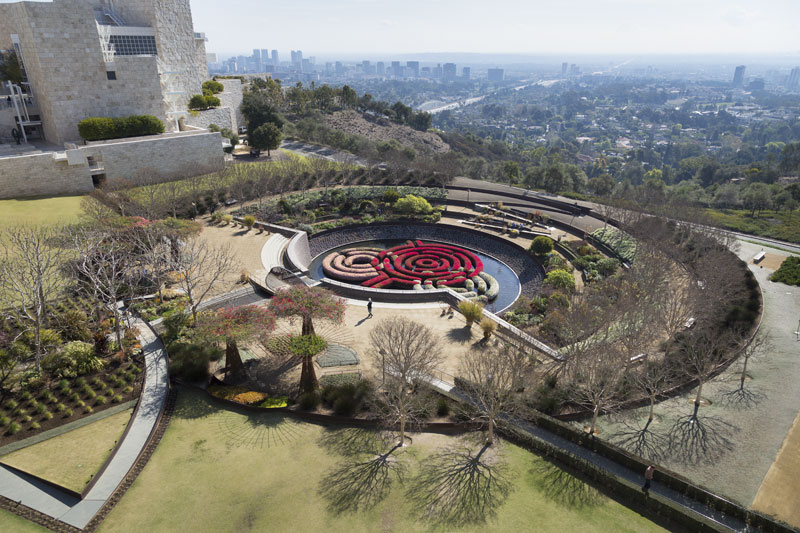
For years, Irwin made no objects at all, working instead as a kind of architectural and landscape consultant. Many projects, including a master plan for the improvement of Miami International Airport, on which he worked for four years in the early 1980s, were never realised. Others, such as the spectacular garden completed in 1998 for the new Getty Center in Los Angeles, and his 2003 transformation of a former factory into the galleries of Dia:Beacon, in upstate New York, were manifested as monumental expressions of Irwin’s ambition and versatility.
The story of Irwin as an artist begins in 1957, when he had his first solo exhibition at Felix Landau Gallery in Los Angeles. Irwin remembers looking around at his Abstract Expressionist paintings, before the private view, and having a dark realisation. ‘They were really fucking bad. Just before the door opens. Woah. This is not good.’ His friends, of course, were all polite, but the painter Craig Kauffman, four years his junior and then one of the most accomplished young artists in the city, sidled up to him and delivered his judgement: ‘You’ve got to be kidding!’
In that moment, says Irwin, he knew he had to ‘knuckle down’ and get serious about art. He admits he ‘didn’t know shit from Shinola about what was going on in the art world,’ so he swallowed his pride and made Kauffman, Billy Al Bengston and Ed Moses – all young artists exhibiting with the now legendary Ferus Gallery – his teachers. Two years later, he was invited by dealers Walter Hopps and Irving Blum to join the Ferus stable. A reviewer for the Los Angeles Times described his first exhibition of large paintings with the gallery: ‘He favors a flamelike turbulence which may erupt in isolated swirls or burst in sheets of color over the surface of the canvas.’
Untitled (1969), Robert Irwin, acrylic paint on cast acrylic, diam. 134.7cm. © Robert Irwin/Artists Rights Society (ARS), New York. Photos: © 2015 Philipp Scholz Rittermann

Irwin was not satisfied with his Expressionist efforts, however, and in the early 1960s his painting made an abrupt turn, becoming radically reductive: two or three horizontal lines, for instance, on a coloured ground, which he would rework fastidiously until the painting began to hum at the intense, high-pitched visual frequency that he was after. In 1966, after experimenting with convex canvases, he dispensed with traditional painting techniques altogether, making polished discs of aluminium and, later, plastic that hovered away from the wall and, in carefully modulated lighting conditions, seemed to lose their edges altogether.
Irwin wondered whether he could achieve the same effect not with an object in space but with the space itself. In his Venice studio, he rounded out the corners between the floors, the walls and the ceilings with smooth plaster, and began experimenting with different artificial light sources, trying to find the most neutral and unobtrusive means of lighting the space. He never found what he was looking for, although it was the fluorescent tube that he felt was the least unsatisfactory, because, he once explained, ‘They are so dumb, so obvious, you tend to discount them.’
At the Museum of Contemporary Art San Diego, four decades later, Irwin made an installation using 115 fluorescent light fixtures, arranged on a diagonally oriented grid across one high wall of the museum. He titled it Light and Space (2007) after the movement that, in the late 1960s, along with James Turrell, Larry Bell, De Wain Valentine, Doug Wheeler, and others, he is credited with founding. The Light and Space movement was a uniquely Southern Californian phenomenon; it was named after two attributes that the region boasted in abundance, and took advantage of local craftsmanship and fabrication techniques associated with custom hot-rod culture, surfboard shaping and aerospace technologies.
Light and Space (2007), Robert Irwin (b. 1928), 115 fluorescent lights, 6.9 ×15.7m (wall). Installation view at Museum of Contemporary Art, San Diego. © Robert Irwin/Artists Rights Society (ARS), New York. Photos: © 2015 Philipp Scholz Rittermann
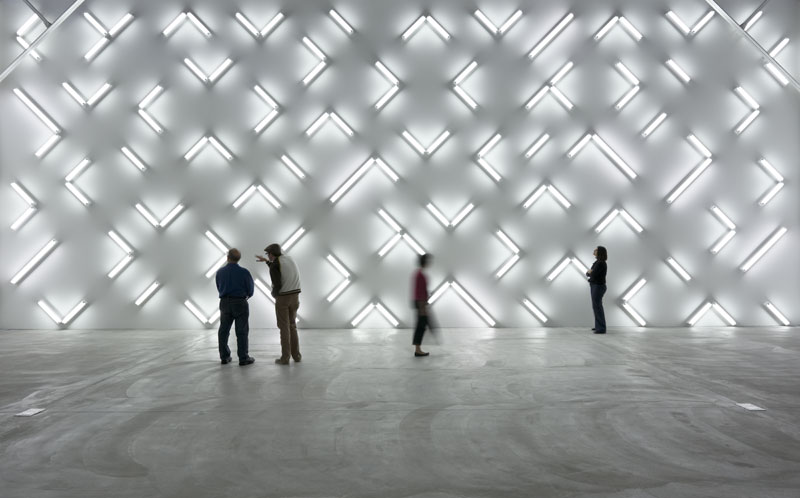
A quintessential Light and Space story surrounds an installation Irwin made in 1970, a commission for a new shopping mall out in Northridge, in the middle of the San Fernando Valley. (For coastal Angelenos like Irwin, native to the south-west part of the city, The Valley – as it is always called – is widely considered off the map, beyond the pale geographically, socially and culturally.) At the time, Irwin had been experimenting with casting clear acrylic to make freestanding vertical columns, designed to be nearly invisible from certain angles and then startlingly prismatic as you moved about them. The works were not meant as obelisks in the manner, say, of John McCracken’s resin planks, but as interventions that would radically alter the viewer’s perception of a given space.
While scouting carpenters’ workshops, Irwin encountered the fabricator Jack Brogan, a man he describes as ‘a mythical figure in the art world, who can solve any problem’. Brogan devised a technique for casting acrylic at a greater thickness and height than had ever before been achieved, producing an optically perfect column with the profile of a winged arrow, 3o feet tall. In Irwin’s yard, the pair clamped the column together in three sections, polishing their surfaces so that the seams would be invisible when joined. The untitled column was the centrepiece of the futuristic Northridge Fashion Center, which opened in 1971. When the Northridge Quake struck in 1994, its epicentre two miles away, Irwin boasts that the column was the only part of the mall that stayed standing. Jack Brogan’s secret method for bonding acrylic was eventually bought by the military, which used it in fighter aircraft cockpits.
Irwin later complained to his friend, the writer Lawrence Weschler (whose biography Seeing is Forgetting the Name of the Thing One Sees is one of the finest examples of its genre) that his columns were perpetually misunderstood because everybody regarded them as sculptures. He considered them tools with which he could examine ‘the quality of a particular space in terms of its weight, its temperature, its tactileness, its density, its feel’. As a result, Irwin generally forbade photography of his artworks, an embargo that he only officially lifted in recent years when he found a photographer – Philipp Scholz Rittermann – who he considered capable of capturing the subtly elusive lighting effects of his installations.
Untitled (1971), Robert Irwin, acrylic column, ht 9.1m. First installed at the Northridge Fashion Center, LA, in 1971. © Robert Irwin/Artists Rights Society (ARS), New York. Photos: © 2015 Philipp Scholz Rittermann

It almost seemed, at times, as if the absolute defiance of pictorial representation was Irwin’s chief objective during the 1970s. On a trip to Amsterdam, he noticed a certain kind of fabric that the Dutch used for translucent window shades; he found a source for this material and used it in numerous gallery installations, typically stretching it tautly across a room in order to create false planes within the architecture, white surfaces that look opaque from one angle and then diaphanous from another. These scrim pieces are hard to focus one’s eye on, let alone a camera.
Irwin’s first public use of this material was in 1970, when he made an intervention into an empty gallery at the Museum of Modern Art, New York. He used the scrim to make a drop-ceiling that covered half of the space; in addition he stretched a nearly-invisible wire horizontally in front of one wall, and he alternated warm and cool fluorescent tubes in the lighting fixtures. Hardly anyone noticed, which was partly the point.
Later, in 1998, Irwin used his then-trademark scrim to create walls in an installation for Dia, New York, titled Prologue: x183. A few months after the work was first installed, the artist returned to reconfigure the piece – which consisted principally of 18 rooms with scrim walls – to include vertical fluorescent tubes covered with coloured lighting gels. This second iteration, titled Excursus: Homage to the Square³, is currently on view at Dia:Beacon; unsurprisingly, given Irwin’s sensitivity to the conditions in which his work is seen, he has further adapted the 1998 version to fit its new environment – one which, years before, he had had a hand in designing.
When Michael Govan, in 2003 the director of the Dia Art Foundation, proposed Irwin to his board as the architect for the new Dia: Beacon, Irwin says, ‘the board said no, we want a real architect!’ Other artists objected too, because they didn’t want their art to be shown inside Irwin’s art. I ask him about his thoughts on the art world’s contemporary fad for cross-disciplinarity: artists dashing off operas, for instance, or designing lines of clothing. ‘I like the idea of planning a city,’ he says. ‘Why not?’ What you’re bringing as an artist, he says, is a sensibility. ‘Really looking at the character and the quality of the materials, the character and quality of all the decisions, so that essentially they all knit and they rhyme. Nobody’s better prepared for it than an artist.’ Ignorance of classical technique can be an advantage, too: ‘What you lack is a commitment to traditional solutions. You start from scratch. You have to do your homework; you have to know that you don’t know.’
Excursus: Homage to the Square³ (2015), Robert Irwin, Tergal voile, fluorescent bulbs, and framing materials. Installation view at Dia:Beacon; Riggio Galleries, New York. © Robert Irwin/Artists Rights Society (ARS), New York. Photos: © 2015 Philipp Scholz Rittermann
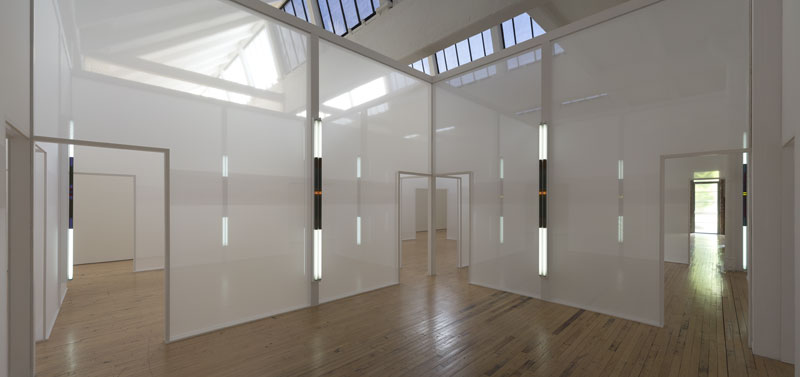
His early detractors at Dia were silenced by a plan for the building that showed a deft lightness of touch, and for a graceful landscaping scheme that contributed to what Irwin describes as ‘just a beautiful place to spend time and to look at things’. He stated similar ambitions when creating his garden at the Getty. Govan, now director of the Los Angeles County Museum of Art, contracted Irwin to redesign the public areas around the museum when Renzo Piano was creating an additional two buildings on the campus. Completed in 2010, Irwin’s Primal Palm Garden is today enjoyed by LACMA visitors who may have no idea that they are experiencing a work of environmental art. It is simply a pleasant place to be.
‘One of the things that pisses people off in New York,’ Irwin tells me, ‘is when you tell them you had a happy childhood. They think that art is all about angst. But growing up here, I had the most fun childhood. I was a lifeguard out on Catalina Island, I was a bouncer at The Attic. And I was a swing dancer. I am of the opinion that art can come out of joy as well as it can come out of angst. I always try and make everything I do as beautiful as possible.’
That radically guileless aspiration has contributed to the body of fluorescent light works to which Irwin has been devoted over the past eight years. While working on Light and Space for his 2007 retrospective, he acquired a studio for the first time since 1980, when he relinquished his Venice studio in order to ‘get out on the road’. Unexpectedly back in the studio near the end of his eighth decade, Irwin began playing around with the fluorescent tubes and coloured gels that had featured in Excursus: Homage to the Square³.
During his exhibition at the Museum of Contemporary Art San Diego, he had begun chatting with one of the guards, a young artist named Joey Huppert. Irwin was bemused to learn that Huppert had read everything he had ever written. ‘Not only had he read everything,’ Irwin says laughing, ‘he wanted to argue about it!’ Irwin had never wanted an assistant before, but he took on Huppert as his studio manager and intellectual sparring partner. ‘It enriched my life,’ he says.
Now when Irwin talks about his work, he often slips into the first person plural: ‘The first two years were so exciting – we were just making colours we had never seen before. After two years, we realised we had absolutely no critical judgement. We were just having fun! So then we realised we were going to have to discipline ourselves a little bit.’ Huppert has devised a notational system for recording the complex colour combinations of the lighting tubes which may, in a single work, mix emitted and refracted light, painted tubes and modified fixtures. ‘You find yourself in an entirely new world of colour!’ says Irwin, excitedly. ‘It’s just spectacular.’ He credits his friend, the late sculptor Ken Price, as doing something similar with layers of ceramic glazes.
Irwin admits that these light pieces have been ‘a bit of a side-trip’, and that he and Huppert are starting to wrap up the project. He admits to having enjoyed the novelty of making things and selling them ‘for the first time in my life’, but he is dismayed by the current state of the art world, with its art fairs and auctions and speculators and skyrocketing prices. ‘It’s a fucking mess, I don’t have to tell you.’
With much contemporary art, he asks, ‘Is it art or is it politics? The answer, in my mind, is that it’s politics.’ Irwin is absolutely clear that the purpose of art is not to create a ‘duck blind from which you can take pot-shots at the world. Art is about attending that’ – and he gently rubs the back of my hand. ‘There’s nothing political about that.’
He describes his view of art in terms of the human brain. ‘We have two kinds of knowing; we have a sentient being, and a cognitive self.’ The former is based in perception, and the latter is grounded in the logic of language. Modern art, which progressed from Jacques-Louis David to Kazimir Malevich in a hundred years, is fundamentally concerned with the former. When Malevich’s friends exclaimed, in Irwin’s paraphrasing, ‘“My god, Malevich, everything we know and love is gone! You’ve left us with a desert!” Malevich says, “Yes, but it’s a desert of pure feeling.”’
As Irwin sees it, Malevich improved on Descartes’ declaration, ‘I think, therefore I am,’ to read instead, ‘I feel therefore I think, therefore I am.’ As he says these words, for an instant, Irwin’s voice trembles and tears come to his eyes. ‘There’s the crux, right there.’ Pure feeling indeed.
‘Excursus: Homage to the Square³’ is at Dia:Beacon, New York, until May 2017.
From the October 2015 issue of Apollo. Preview and subscribe here.

